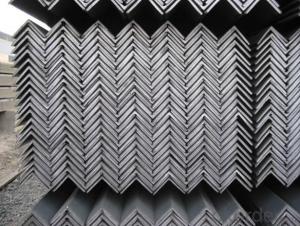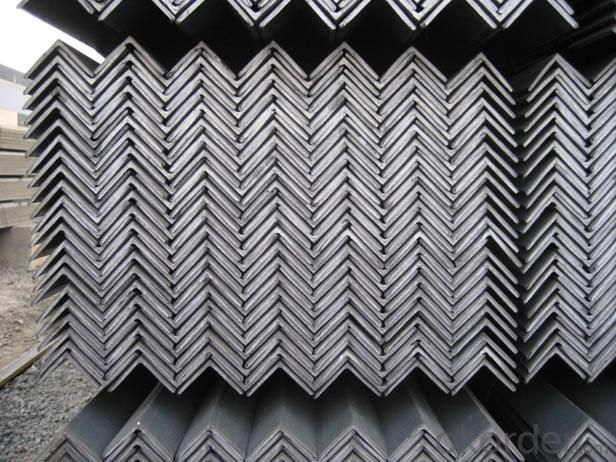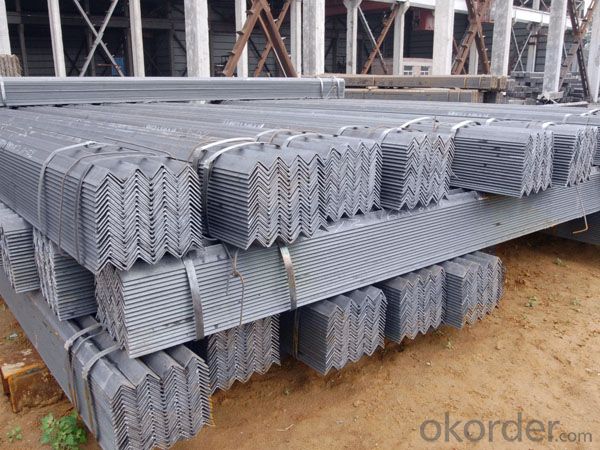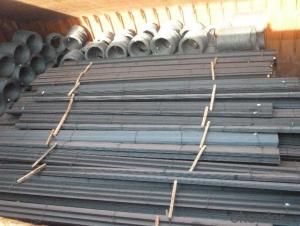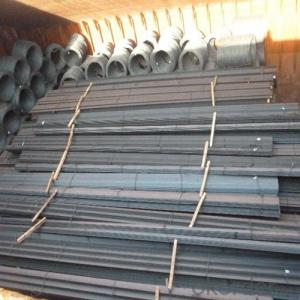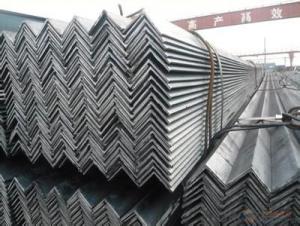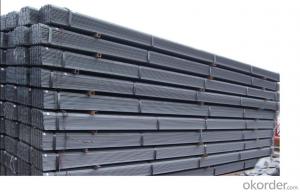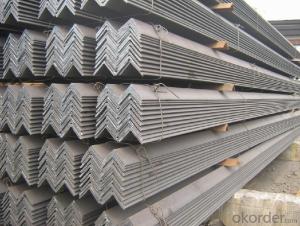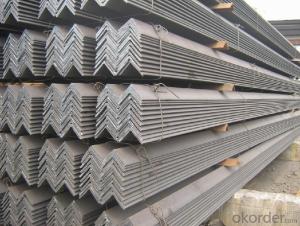Angle Steel Hot Rolled ASTM A36 Or Q235B
- Loading Port:
- Tianjin
- Payment Terms:
- TT OR LC
- Min Order Qty:
- 25 m.t.
- Supply Capability:
- 20000000 m.t./month
OKorder Service Pledge
OKorder Financial Service
You Might Also Like
Product Description:
OKorder is offering high quality Hot Rolled Steel I-Beams at great prices with worldwide shipping. Our supplier is a world-class manufacturer of steel, with our products utilized the world over. OKorder annually supplies products to European, North American and Asian markets. We provide quotations within 24 hours of receiving an inquiry and guarantee competitive prices.
Product Applications:
According to the needs of different structures, Angle can compose to different force support component, and also can be the connections between components. It is widely used in various building structures and engineering structures such as roof beams, bridges, transmission towers, hoisting machinery and transport machinery, ships, industrial furnaces, reaction tower, container frame and warehouse etc
Product Advantages:
OKorder's Steel I-Beams are durable, strong, and resist corrosion.
Main Product Features:
· Premium quality
· Prompt delivery & seaworthy packing (30 days after receiving deposit)
· Corrosion resistance
· Can be recycled and reused
· Mill test certification
· Professional Service
· Competitive pricing
Product Specifications:
Manufacture: Hot rolled
Grade: Q195 – 235
Certificates: ISO, SGS, BV, CIQ
Length: 6m – 12m, as per customer request
Packaging: Export packing, nude packing, bundled
Sizes: 25mm-250mm | ||||||||||
a*t | ||||||||||
25*2.5-4.0 | 70*6.0-9.0 | 130*9.0-15 | ||||||||
30*2.5-6.6 | 75*6.0-9.0 | 140*10-14 | ||||||||
36*3.0-5.0 | 80*5.0-10 | 150*10-20 | ||||||||
38*2.3-6.0 | 90*7.0-10 | 160*10-16 | ||||||||
40*3.0-5.0 | 100*6.0-12 | 175*12-15 | ||||||||
45*4.0-6.0 | 110*8.0-10 | 180*12-18 | ||||||||
50*4.0-6.0 | 120*6.0-15 | 200*14-25 | ||||||||
60*4.0-8.0 | 125*8.0-14 | 250*25 | ||||||||
FAQ:
Q1: Can stainless steel rust?
A1: Stainless does not "rust" as you think of regular steel rusting with a red oxide on the surface that flakes off. If you see red rust it is probably due to some iron particles that have contaminated the surface of the stainless steel and it is these iron particles that are rusting. Look at the source of the rusting and see if you can remove it from the surface.
Q2: How do you package the angle steel when shipping?
A2: All goods are packed in bundles with steel strips and shipped by container or break bulk.
Q3: The products are invoicing on theoritical weight or on actual weight?
A3: According to the customers' request,both of the two is OK.
- Q: How are steel angles cut to specific lengths?
- To achieve specific lengths, various cutting tools and techniques are employed for steel angles. Among these, a common approach involves the use of saws, such as band saws or circular saws with metal-cutting blades. By securely clamping or holding the angle in place, a precise and clean cut can be made as the saw blade is guided along the desired cutting line. Alternatively, an abrasive cutting wheel, also known as a cutoff wheel or grinding disc, can be utilized. This method is particularly suitable for thinner steel angles or situations requiring a more accurate cut. By securing the angle in a vise or similar holding device, the cutting wheel is cautiously guided along the marked cutting line, removing excess material. For larger and thicker steel angles, plasma cutters or oxy-fuel torches are viable options. Both methods involve elevating the steel's temperature to a point where it either melts or oxidizes, enabling a meticulous and precise cut. Plasma cutters utilize a focused jet of ionized gas, while oxy-fuel torches employ a combination of oxygen and a fuel gas, like acetylene or propane. In certain cases, more specialized techniques such as water jet cutting or laser cutting can be utilized to cut steel angles. Water jet cutting employs a high-pressure stream of water mixed with abrasive particles to erode the steel, while laser cutting relies on a concentrated laser beam to melt or vaporize the material along the intended cutting path. Regardless of the chosen method, it is crucial to firmly secure the angle in place and accurately guide the cutting tool along the marked cutting line. When cutting steel angles to specific lengths, it is important to prioritize safety by taking appropriate precautions like wearing protective eyewear and gloves.
- Q: Can steel angles be used for framing purposes?
- Framing purposes can indeed involve the utilization of steel angles. In construction and engineering, steel angles are frequently employed to furnish structural support and ensure stability. Their application often involves the construction of frames for an assortment of structures, including buildings, bridges, and more. By welding or bolting steel angles together, a robust and inflexible framework can be created with ease. These angles possess versatility and can be effectively employed in diverse framing scenarios, such as supporting walls, beams, and roofs. Moreover, their durability and exceptional strength-to-weight ratio render steel angles highly suitable for framing endeavors.
- Q: Can steel angles be used for manufacturing staircases?
- Yes, steel angles can be used for manufacturing staircases. Steel angles are commonly used in construction and fabrication due to their strength, durability, and versatility. When used for staircases, steel angles can provide the necessary support and structural integrity required to ensure the safety and stability of the staircase. They can be used to create the framework, stringers, and risers of the stairs, providing a solid base for the steps. Steel angles can be easily welded, bolted, or otherwise connected to form a sturdy staircase. Additionally, they can be easily customized to fit specific design requirements and can be coated or painted to enhance their aesthetic appeal. Overall, steel angles are a popular choice for manufacturing staircases due to their strength, durability, and adaptability.
- Q: Are there any limitations or restrictions on the use of steel angles in certain applications?
- Yes, there are limitations and restrictions on the use of steel angles in certain applications. One limitation is the maximum load-bearing capacity of the steel angles. Depending on the size, thickness, and quality of the steel angles, they may have a limited ability to support heavy loads. Therefore, in applications where high strength and load-bearing capacity are required, alternative structural members such as steel beams or columns may be more suitable. Another restriction is the suitability of steel angles for specific shapes or configurations. Steel angles are typically L-shaped, and while they are versatile and commonly used in various applications, they may not be ideal for certain complex or curved designs. In such cases, custom-shaped structural members or other materials may be more appropriate. Additionally, the corrosion resistance of steel angles is a limitation in certain environments. Steel is susceptible to rust and corrosion, particularly in marine or highly humid conditions. In applications where exposure to moisture or corrosive substances is inevitable, additional protective measures such as coatings or stainless steel angles may be required. Lastly, the fabrication and installation of steel angles may also impose limitations. Steel angles often require welding, cutting, or drilling during fabrication, which can be challenging in certain applications where precision and specialized equipment are necessary. Moreover, the size and weight of steel angles may pose limitations during transportation and installation, especially in confined spaces or areas with limited access. Therefore, it is crucial to consider these limitations and restrictions when selecting steel angles for specific applications, ensuring that they meet the required strength, shape, corrosion resistance, and installation requirements.
- Q: What are the different types of corrosion protection coatings for steel angles?
- There are several types of corrosion protection coatings available for steel angles, each designed to provide varying levels of protection against corrosion. 1. Paint Coatings: One of the most common types of corrosion protection coatings for steel angles is paint. Paint coatings act as a barrier between the steel surface and the corrosive elements in the environment. They are usually applied in multiple layers and can be customized to meet specific requirements, such as resistance to chemicals or UV radiation. 2. Galvanizing: Galvanizing is another widely used corrosion protection method for steel angles. It involves applying a layer of zinc to the steel surface through a process called hot-dip galvanizing. This coating provides excellent protection against corrosion as the zinc layer acts as a sacrificial anode, corroding before the steel does. Galvanized steel angles are commonly used in outdoor applications where they may be exposed to moisture and harsh weather conditions. 3. Powder Coatings: Powder coatings are a type of protective coating that is applied as a dry powder and then cured using heat. They provide a durable and corrosion-resistant finish to steel angles. Powder coatings can be customized in terms of color, texture, and thickness, offering both aesthetic appeal and enhanced protection against corrosion. 4. Epoxy Coatings: Epoxy coatings are often used for industrial applications where steel angles may be exposed to harsh chemicals or abrasive environments. These coatings form a strong, protective layer that resists corrosion, as well as chemicals, solvents, and abrasion. Epoxy coatings can be applied as a single layer or in combination with other coatings for added protection. 5. Organic Coatings: Organic coatings, such as polyurethane or acrylic coatings, are commonly used in architectural applications where steel angles require protection from corrosion while maintaining an aesthetically pleasing appearance. These coatings provide good resistance to weathering, UV radiation, and corrosion, ensuring the longevity of the steel angles. It is important to consider the specific application, environmental conditions, and budget constraints when selecting a corrosion protection coating for steel angles. Consulting with a corrosion specialist or coating supplier can help determine the most suitable coating for the intended use.
- Q: 100 x 100 x 10 equal angle steel, per meter weight?
- Angle steel is a kind of carbon structural steel for construction. It is a simple section steel, mainly used in the frame of metal component and workshop. In use, better weldability, plastic deformation and mechanical strength are required. The raw steel billet for producing angle steel is low carbon square billet, and the finished product angle iron is made by hot rolling, normalizing or hot rolling.
- Q: What are the limitations of using steel angles in highly corrosive or chemical environments?
- The limitations of using steel angles in highly corrosive or chemical environments stem from the inherent nature of steel and its vulnerability to corrosion. To begin with, steel angles are primarily composed of carbon steel, which has a tendency to rust when exposed to moisture or chemicals. In environments with high corrosion potential, such as those containing acids, alkalis, or saltwater, the steel angles may corrode at an accelerated rate, which can compromise their structural integrity. Additionally, these steel angles may also experience pitting corrosion in such environments. Pitting corrosion occurs when localized chemical reactions result in the formation of small pits or holes on the steel surface. This phenomenon weakens the angles and diminishes their load-bearing capacity. Another drawback is that steel angles may lack resistance to specific chemicals or substances. Certain chemicals can trigger reactions with the steel, leading to degradation or even catastrophic failure. For example, strong acids or bases can inflict severe damage on the steel angles, potentially resulting in structural collapse. Moreover, steel angles in corrosive environments often require supplementary protective measures like coatings or corrosion inhibitors to enhance their resistance. However, implementing these additional measures can escalate the cost and maintenance demands of the structure. To summarize, while steel angles find widespread use in various applications, their suitability in highly corrosive or chemical environments is limited due to their susceptibility to corrosion and potential chemical reactions. It is crucial to consider alternative materials or employ protective measures to ensure the angles' structural integrity and longevity in such environments.
- Q: What are the different types of steel angles used in door and window frames?
- Door and window frames commonly utilize different types of steel angles, each with its own advantages and uses. Firstly, the L-shaped angle is the most frequently employed steel angle in these frames. It possesses a 90-degree angle and is primarily used to provide structural support and reinforcement. L-shaped angles are versatile, allowing for easy welding or bolting into place, making them suitable for various frame designs. Secondly, T-shaped angles, as the name suggests, resemble the letter "T" in their cross-section. They are often incorporated to enhance the strength and stability of door and window frames. T-shaped angles are commonly utilized in heavy-duty applications where increased load-bearing capacity is necessary. Equal angles, with two equal sides forming a 90-degree angle, are also commonly found in door and window frames. These angles are ideal for applications requiring equal support on both sides. Their usage ensures symmetry and balance, thereby maintaining frame stability and levelness. On the other hand, unequal angles possess sides of varying lengths. They are frequently utilized in door and window frames that require differing levels of support on each side. Their versatility allows them to compensate for differences in wall thickness or other structural considerations. Lastly, slotted angles are often preferred for door and window frames that require adjustable or modular designs. They incorporate a series of holes or slots along their length, facilitating easy attachment and customization. Slotted angles are commonly employed in DIY projects or applications that prioritize flexibility and adjustability. It is important to note that the selection of a steel angle for door and window frames depends on various factors such as the specific application, load-bearing requirements, and aesthetic considerations. Seeking consultation from a structural engineer or a professional in the field can aid in determining the most suitable type of steel angle for a particular project.
- Q: Can steel angles be used for platform structures?
- Yes, steel angles can be used for platform structures. Steel angles are commonly used in construction for their strength, durability, and versatility. They provide structural support and stability to various types of platforms, including elevated walkways, mezzanines, catwalks, and scaffolding. Steel angles offer excellent load-bearing capacity and can withstand heavy loads, making them suitable for platform structures that require a high level of strength and stability. Additionally, steel angles can be easily fabricated and joined together, allowing for efficient construction and customization of platform structures.
- Q: Can steel angles be used in decorative or architectural applications?
- Indeed, decorative or architectural applications can make use of steel angles. With their versatility, steel angles can be manipulated and shaped to form a variety of architectural elements. These elements include decorative trims, ornamental railings, window frames, door frames, and even structural features like support brackets. Furthermore, steel angles can undergo different coatings or finishes to enhance their aesthetic appeal. These enhancements may involve painting, powder coating, or patina finishes. Due to their strength and durability, steel angles are suitable for both indoor and outdoor applications. They provide structural integrity and simultaneously add a visually pleasing element to the design. Overall, steel angles offer a plethora of design possibilities and can be effectively incorporated into decorative or architectural applications.
Send your message to us
Angle Steel Hot Rolled ASTM A36 Or Q235B
- Loading Port:
- Tianjin
- Payment Terms:
- TT OR LC
- Min Order Qty:
- 25 m.t.
- Supply Capability:
- 20000000 m.t./month
OKorder Service Pledge
OKorder Financial Service
Similar products
Hot products
Hot Searches
Related keywords
